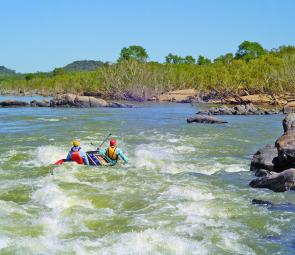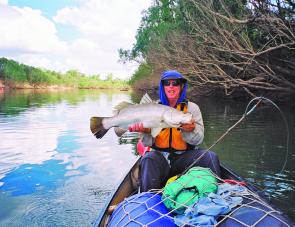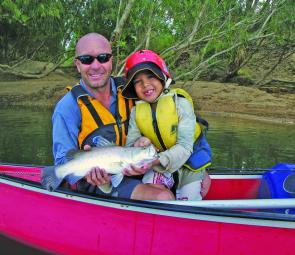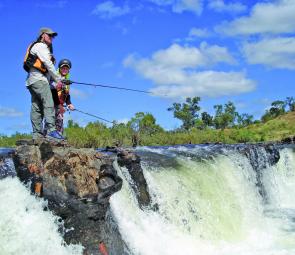It’s time to get down to the serious business of fishing. As stated in the October issue of QFM, for me fishing is the main course, while for others on our canoe trips, it is merely a side dish. If I was told that I was not allowed to fish during the expedition, I’d give serious thought to whether I went at all!
Fishing from a canoe is a completely different ballgame to fishing from a normal boat. For starters there is the need to balance the craft, with the added incentive that many of the waters we paddle are home to bull sharks and estuarine crocodiles. Include the need to cast from a low seat position, probably only 10cm off the water, and there is a definite art to it.
Having grown up in watercraft of all shapes and sizes, I wasn’t fully aware of the difficulty of adapting to this technique until the past two trips when Brad Weaver recounted the difference it made to his fishing enjoyment this year, when he went to the trouble of practicing his casting techniques in the lead up to departure. He reported a significant improvement in distance and accuracy of casting, and with it, a far higher degree of satisfaction from the fishing experience, in spite of the barra numbers being significantly down this year.
Brad set up a small low set stool in the back yard and a bucket of water and practiced casting the lure into the bucket from various angles. Keep in mind that the wider the angles you can cast from a seated position, the far greater ability you will have to put the lure tight in against structure, where the huge majority of fish are lurking. This doesn’t apply to catfish however, which are more often out in the open. So it goes without saying that the more accurate your casting, the fewer catfish hooked and the more barra and sooty grunter encountered. Added incentive indeed!
Why not forget about casting and just troll? Good in theory but in practice it has its pitfalls. The biggest one being the high correlation between the amount of time spent trolling and the percentage of catfish making up the catch. The other issue is that in a lot of the better, fast running water, trolling is not an option. It is only possible in the big slow flowing holes, which the catties just love. The concentration of catfish also seems to increase at the bottom end of holes, with sooties and barra more likely to be encountered at the start of waterholes, where it first drops into deep water. Any area where there is water running over a good drop-off, especially if there is a bit of rock or snags to offer some cover, our prized catches will be encountered.
In case you haven’t picked up on it yet, I have a distinct aversion to catfish! Even in my everyday fishing I don’t like the whiskered beasts for no better reason than they are slimy and spiky. When I force myself to take off my catfish hating filter, they are in fact quite good to eat. You just won’t find them in my fry pan! Some of the biggest volume commercial species in Australia are actually catfish dressed up in fancy names and dressed down to a skinless, boneless fillet. The likes of fish marketed as basa, green, blue and river cobbler, Pacific dory and panasius are simply catfish clad in a fancy name.
The real problems with catfish when canoe fishing are many fold. Having a spiky, slimy beast that jumps and flicks in all directions in the confines of a canoe is a recipe for disaster. On a more serious note, a good hit from a catfish spine will put you in hospital – a facility in short supply in the remote areas we canoe! Lifting a catfish into a canoe is simply looking for trouble. That leaves unhooking the slippery little monster outside the boat, which brings up the balance paradigm again.
Leaning over the side to deal with a highly agitated bundle of spikes has its own set of challenges. The other X factor is the ability of a thrashing fish to attract the unwanted attention of sharks and crocs to your tiny little craft! Consequently you become very adept at removing catfish from a lure. A pair of pointy nose pliers of some sort is a must. The best technique is to pull the cattie tight against the gunwale with the leader, wait for the commotion to subside, then grab the treble with the pliers and twist and shake, without getting the catfish in a position where it can flick and land with a spine in your leg or hand. A definite art form in itself - but one best mastered.
Rods are definitely the way to go. Old Baz Merritt fished with a hand line with very little success last year. The challenge with rods however is getting them there in one piece and then keeping them that way for the duration of the journey. I always take two rods. A one piece and a three piece as a backup. After years of no problems during transit, I became complacent last year and put my one piece rod in the canoe trailer rather than inside the vehicle. We arrived at the river and I found two runners crushed by the barrels that had moved on the rough roads. I always carry spare rod tips and super glue but not standard runners, so I was immediately down to my three piece back-up. It just made it through the trip with three running repairs to the tip, which broke off when caught on various things. A straightened hook did as an internal sleeve strengthener and I super glued it in and bound it with Gaffa tape. Not the best but it did the job.
It also pays to carry a spare reel. Last trip, the level wind on my favourite reel packed it in on day one, but fortunately I had an identical back up in my barrel. I use good quality baitcaters but it is best to go with whatever you are more comfortable casting. Baitcasters tend to stand up better to the rough and tumble of canoeing than egg beaters, so if you can use both, go with the baitcaster. Another consideration is using a reel that can handle a swim or two. Invariable it ends up in the water at some stage – usually when you turn turtle in the canoe. A drag that still works is the key ingredient. I have found the Calcutta 200 series reel and the Daiwa CVZ range handle a swim pretty well.
Rod security is another challenge. When I first started canoe expeditions, I used to tie the rod to the canoe with about 1.5m of cord in case it went over the side. I found this to be a real pain, as it is one more thing to get tangled in. By the end of the first trip I had ceased with the leg rope and have never lost a rig over the side. That doesn’t mean it hasn’t happened though. The record is pretty good however, with only two rigs lost to the depths in six trips. The latest occurred this year when John Sellars made a tactical error and placed his rod sideways across the canoe while he repositioned his craft for a better cast. The lure was dangling in the water, and I will leave the rest to your imagination. We dredged the hole with lures and hooks for half an hour but no luck!
Rods are most at risk of loss or damage in the running water between holes but this is also the area where the fish abound, so the key is to store the rod securely but also have it easy to access. I have found that sliding the tip under the tie downs for the barrels and then attaching the butt to a perimeter cord, that goes all the way around the inside of the canoe, with a Velcro strap, the best and quickest release method. The perimeter cord is great for tying all sorts of things to, and it is the first thing I install in my canoe, at the start of each trip. I use strong cord and do a wrap around all the cross braces and seats, tight against the sides, and tie off front and back. It is great for attaching water bottles, day bags and the like, with carabineers, and also acts as the tie-off point for the net I lash the barrels in with. If any part of the rod is protruding above the gunwale you can be assured it will find a tree or rock to snap off on. The back–up three piece rod is taped under my seat, inside its hard bodied case.
Next issue I will ramble about the all important terminal end of the fishing gear. Until then start dreaming and most importantly start planning!
Reads: 2934
Another consideration is using a reel that can handle a swim or two. Invariable it ends up in the water at some stage – usually when you turn turtle in the canoe.

A straightened hook did as an internal sleeve strengthener and I super glued it in and bound it with Gaffa tape. Not the best but it did the job.

Why not forget about casting and just troll? Especially if dad provides the paddle power. Baedyn McClelland sitting back and enjoying the ride.

Any area where there is water running over a good drop-off, especially if there is a bit of rock or snags to offer some cover, our prized catches will be encountered.

Brad and young Finn Weaver with Finn’s first barra.

Sooties and barra are more likely to be encountered at the start of waterholes, where it first drops into deep water.




